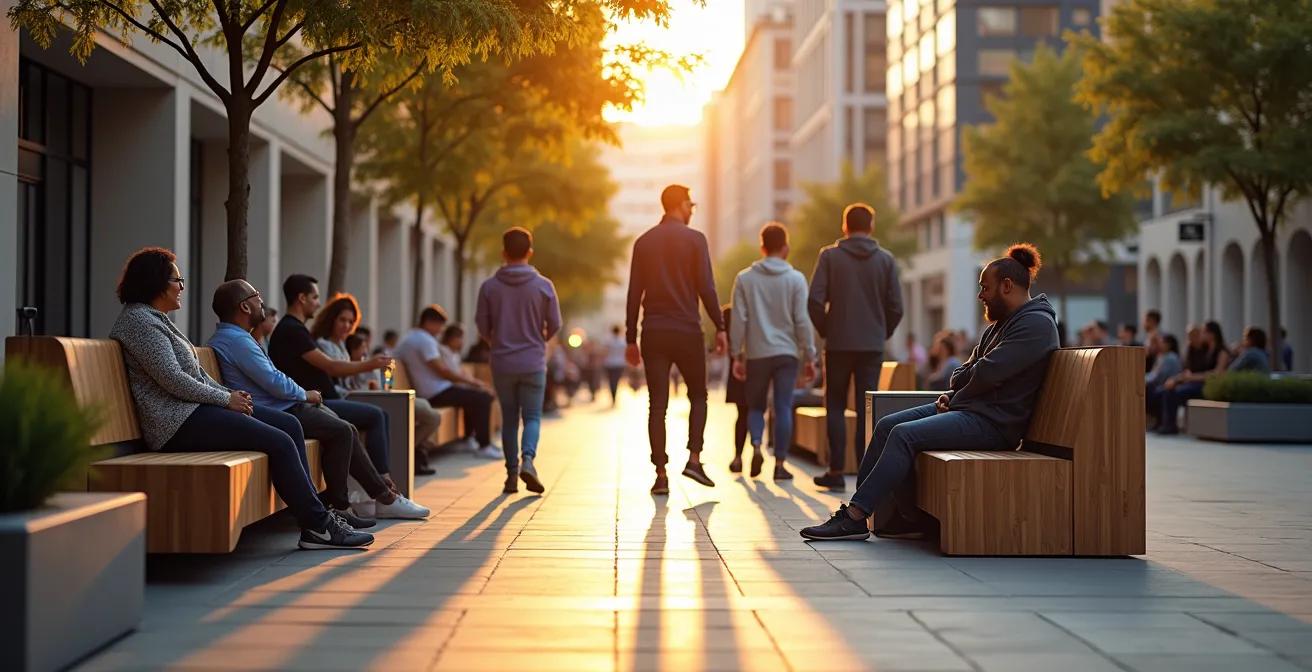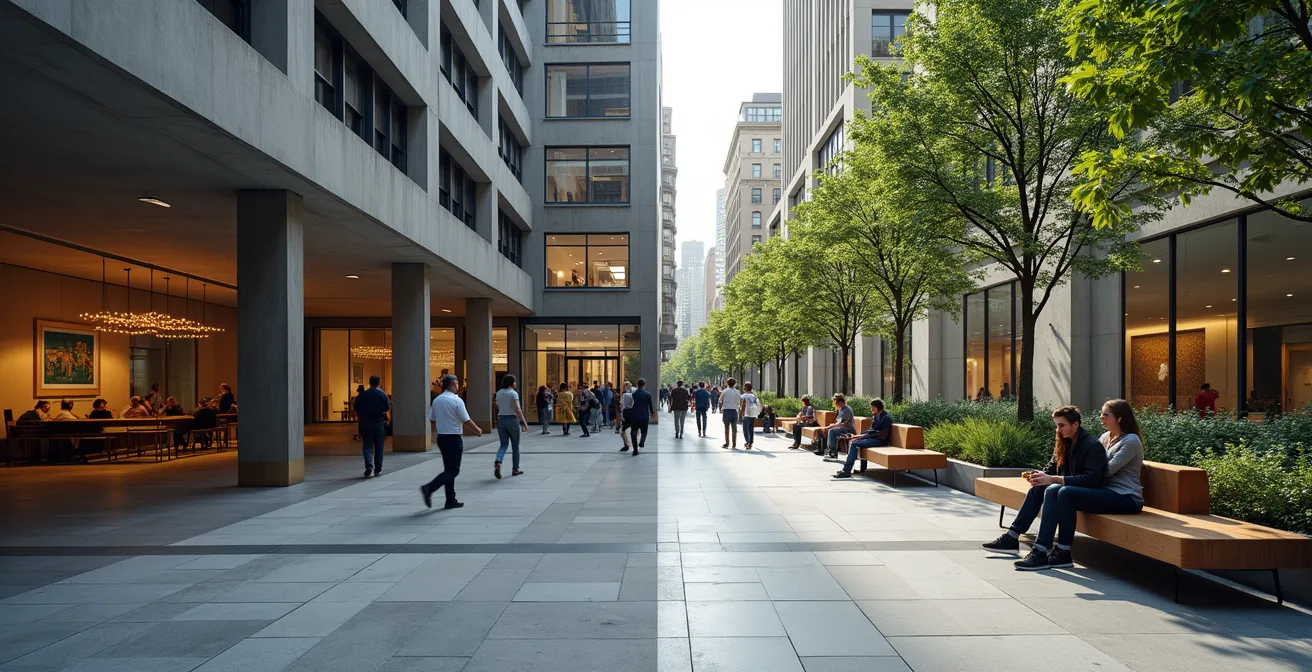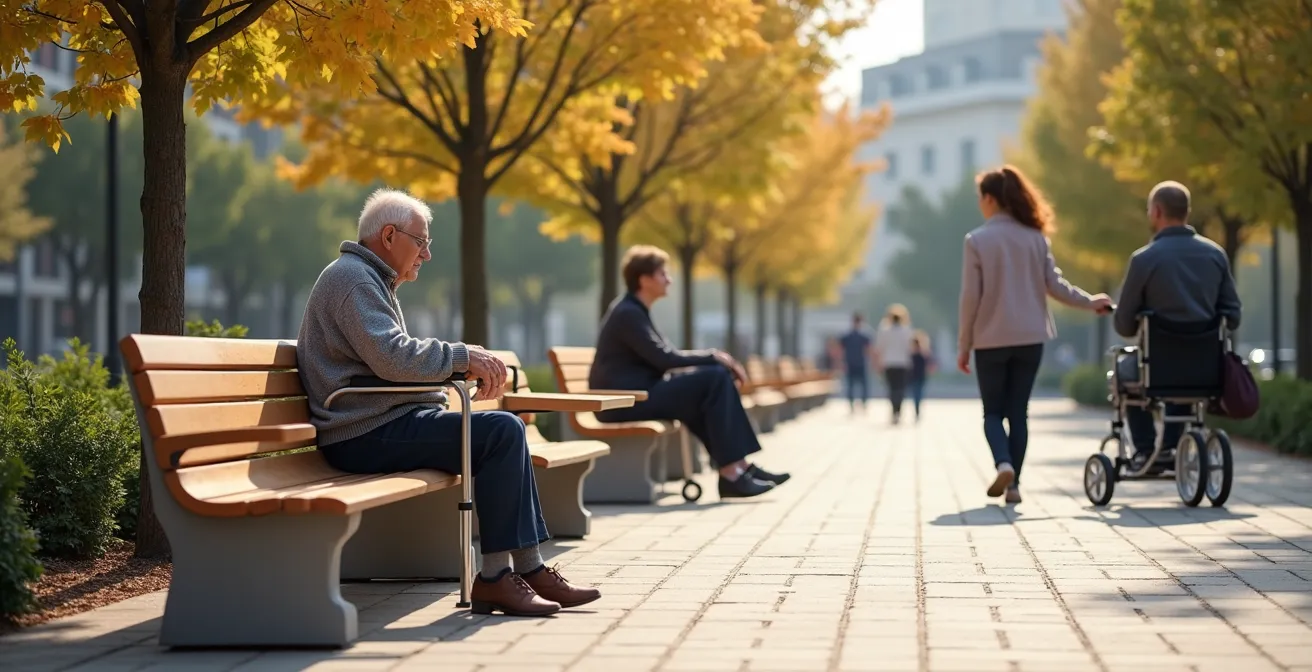
We often walk past benches, bollards, and bins without a second thought, viewing them as simple background elements of the urban landscape. But this perspective overlooks a powerful truth: street furniture is not passive. It actively scripts our behavior, shapes our social interactions, and defines our psychological experience of a city. The design, placement, or even absence of these elements creates an invisible language that tells us whether to linger, to connect, or to hurry along.
From encouraging community gathering to creating subtle barriers, these installations are a core part of a city’s operating system. Understanding their role is crucial for appreciating the complex forces that influence our daily convenience and sense of belonging. Well-designed public spaces rely on a deep understanding of how the street furniture, such as those developed by procity.eu can transform a simple thoroughfare into a thriving public realm, directly impacting the well-being of its inhabitants.
The Urban Script in 5 Key Points
- Behavioral Scripting: Street furniture actively directs pedestrian flow, social interaction, and the overall use of public space.
- Psychological Impact: Its absence creates feelings of unease, while thoughtful design fosters a sense of safety and welcome.
- Radical Inclusivity: Universal design principles in furniture go beyond basic accessibility to serve all community members.
- Sustainable Identity: Material choices reflect a city’s environmental values and commitment to long-term durability.
- Economic Vitality: Strategic investment in quality urban amenities yields tangible returns in community well-being and economic activity.
An urban space devoid of amenities speaks volumes. Sterile plazas and long, bench-less boulevards can evoke a sense of unease or abandonment, subtly communicating that these are not places for people, but for passage. This absence creates a hidden friction in our daily routines, forcing us to ask where we can comfortably wait for a friend, enjoy a quick snack, or simply rest our legs. It discourages the spontaneous social encounters that build community fabric.
This effect is particularly pronounced for vulnerable populations. For the elderly, parents with strollers, or individuals with mobility challenges, a lack of resting points can render entire sections of a city inaccessible. Research indicates that well-furnished public spaces can lead to a 30% increase in social conversations and collaborations, transforming sterile environments into vibrant social hubs. The absence of these elements, therefore, is not a neutral design choice; it is an act of exclusion.

The psychological toll of such environments is significant, as they can inadvertently foster isolation rather than connection. As experts have noted, the daily experience of a city is profoundly shaped by these seemingly minor details.
Urban furniture unconsciously shapes our city experience, habits and feelings. The city experience is actually a sum of the streets, roads, parks, playgrounds and gardens that people interact with every day.
– KroneMag Research Team, KroneMag Urban Design Research
Cities may avoid investing in quality furniture due to perceived high initial costs. However, this short-term view ignores the substantial long-term expenses associated with maintenance, repair, and replacement of inferior products, which ultimately impacts the urban experience.
Melbourne’s Life Cycle Cost Analysis of Street Furniture Materials
The City of Melbourne conducted a comprehensive 25-year lifecycle cost comparison between carbon steel and stainless steel street furniture. The study revealed that initial higher investment in quality materials resulted in significant long-term savings. Products included 1200 waste bins, 500 recycling bins, 800 seats, 400 benches and 80 drinking fountains, demonstrating the economic impact of material choices on urban infrastructure. Source
Street furniture acts as a powerful non-verbal communicator, subtly influencing our perceptions of safety, civility, and value. The choice of materials, from sleek stainless steel to warm, natural wood, sends immediate signals about a space’s identity. Well-maintained, aesthetically pleasing furniture can elevate the perceived safety of an area, encouraging people to spend more time there and engage more freely with their surroundings.
This is because our brains are wired to respond to the environment. As urban planning research suggests, human activity constantly adapts and responds to the ambiance of a space. By thoughtfully improving the urban environment design, planners can guide pedestrian flow, create natural gathering spots, and transform passive streets into active, engaging public realms. Design elements like curved edges can feel more welcoming than sharp angles, subconsciously making a space more comfortable and conducive to social interaction.
The following data highlights how different materials can directly impact user perception and the associated maintenance burden, which in turn affects the long-term quality of the public space.
| Material Type | Perceived Safety Rating | Maintenance Frequency | User Engagement Level | Vandalism Resistance |
|---|---|---|---|---|
| Stainless Steel | High (4.2/5) | Low (Annual) | High | Excellent |
| Recycled Plastic | Medium (3.5/5) | Very Low (Bi-annual) | Medium-High | Good |
| Traditional Wood | Medium (3.2/5) | High (Quarterly) | High | Poor |
| Carbon Steel | Low (2.8/5) | Very High (Monthly) | Low | Poor |
The measurable impact of quality street furniture is striking. When amenities are present and well-designed, people’s behavior changes dramatically. They stay longer, interact more, and feel safer, which are all key indicators of a healthy and vibrant public space.
| Behavioral Metric | With Quality Street Furniture | Without Street Furniture | Improvement Rate |
|---|---|---|---|
| Average Dwell Time | 12.5 minutes | 3.2 minutes | +290% |
| Social Interactions per Hour | 45 interactions | 12 interactions | +275% |
| Willingness to Walk/Bike | 72% positive response | 28% positive response | +157% |
| Perceived Safety Rating | 4.1/5 | 2.3/5 | +78% |
To achieve these positive outcomes, urban planners can follow a set of core principles that connect design choices directly to desired human behaviors.
Behavioral Design Principles Checklist
- Position furniture kerbside with minimum 500mm clearance from travel paths to maintain accessibility
- Apply universal design principles including equitable use and flexibility in design
- Select materials with proven durability like Australian Hardwoods or aluminum for longevity
- Provide regular seating intervals to offer frequent rest opportunities for all users
- Mark pathway obstructions with clear hazard signage for visual accessibility
- Consider the spacing and navigation impact of furniture placement on pedestrian flow
True inclusivity in urban design extends far beyond meeting minimum compliance standards. It requires a deep consideration of the diverse needs of the entire community, from sensory inputs for the neurodivergent to specific mobility challenges faced by the elderly. Thoughtfully designed street furniture is a cornerstone of this effort, fostering a sense of belonging for every citizen.
This is where the principles of universal design become paramount. Universal design aims to create environments and products that are inherently usable by everyone, regardless of age, ability, or status, without the need for special adaptations. This could mean providing benches at varying heights, ensuring tables accommodate wheelchair users alongside their companions, or integrating tactile cues for the visually impaired. Providing recommended intervals for accessible resting facilities of 100-200m is a simple yet profound way to enhance urban mobility for all.
What is universal design in street furniture?
Universal design is the practice of creating street furniture that is inherently accessible and usable by all people, regardless of their age, size, or disability, without needing specialized adaptations.
The following image illustrates how various design elements can come together to create a space that is welcoming and functional for people with a wide range of needs, promoting comfort and intergenerational interaction.

Technological innovation is also pushing the boundaries of what’s possible, creating adaptive environments that respond to individual user needs in real-time.
Responsive Street Furniture for Visual Impairment Adaptation
Innovative street furniture prototypes developed by Ross Atkins and Jonathan Scott demonstrate adaptive technology for disabled users. The system uses proximity tags to automatically adjust lighting levels, provide audio information, and offer extended crossing times. Users can customize services through a web interface, selecting features like extra seating, brighter street lights, and extended traffic signal timing based on individual needs. Source
To effectively implement universal design, planners can focus on specific enhancements that go beyond standard accessibility codes, benefiting a broader segment of the population.
| Design Element | Accessibility Standard | Universal Design Enhancement | Benefit Population |
|---|---|---|---|
| Seating Height | 0.45m above floor level | Multiple height options | Elderly, mobility-impaired, children |
| Wheelchair Space | 1.20m adjoining clearance | Integrated companion seating | Wheelchair users, caregivers |
| Table Accessibility | 0.75-0.90m height, 0.60m depth | Adjustable or varied heights | Wheelchair users, different age groups |
| Tactile Features | Surface texture changes | Multi-sensory wayfinding | Visually impaired, cognitive disabilities |
The choice of materials for street furniture extends beyond aesthetics and durability; it is a public statement of a community’s environmental values. A sustainable approach requires a full lifecycle analysis, considering everything from manufacturing emissions and repairability to end-of-life recycling. It’s a shift from a disposable mindset to one of long-term stewardship.
This mindset is gaining traction, with a projected 8.11% CAGR for the recycled and upcycled materials segment through 2030. Furthermore, sustainable furniture can play an active role in supporting local ecosystems. Integrated planters designed for pollinators, permeable bases that aid in water management, and materials that sequester carbon all contribute to a healthier urban environment and reinforce a community’s green identity, fostering civic pride.
Implementing materials like reclaimed wood, recycled plastics, or even repurposed metals can significantly contribute to sustainability efforts. Efficient design crafting street furniture with a focus on longevity and durability reduces the need for frequent replacements, thereby minimising waste accumulation.
– BlueStream Environmental Research, Street Furniture as a Canvas for Urban Sustainability
Innovative projects worldwide are demonstrating that sustainability can also be a powerful tool for community engagement, turning waste into a valuable resource for urban design.
Print Your City: Community-Driven Recycled Plastic Street Furniture
The Rotterdam-based ‘Print Your City’ project transforms household plastic waste into personalized street furniture through 3D printing and community engagement. In Thessaloniki, Greece, the initiative recycled 4 tons of plastic waste and received over 3000 citizen designs. Citizens bring their plastic waste to laboratories and design customized benches, bicycle racks, and exercise equipment for their neighborhoods, combining environmental awareness with community participation in urban design. Source
Comparing the environmental impact across the entire lifecycle of different materials reveals that the most sustainable choice is not always the most obvious one.
| Material | Manufacturing Carbon Footprint | Durability (Years) | Recyclability | Maintenance Impact |
|---|---|---|---|---|
| Recycled Plastic | Low (-60% vs virgin) | 15-25 | 100% recyclable | Minimal |
| FSC Certified Wood | Very Low (Carbon negative) | 10-15 | Biodegradable | Medium |
| Corten Steel | Medium | 50+ | 100% recyclable | Very Low |
| Stainless Steel | High | 25-50 | 100% recyclable | Very Low |
Key Takeaways
- Street furniture is not passive decor but an active system that scripts public behavior and interaction.
- The absence of amenities creates invisible barriers, particularly for elderly and mobility-impaired individuals.
- Universal design in furniture moves beyond compliance to foster genuine inclusivity for all community members.
- Sustainable material choices reflect a city’s environmental commitment and enhance long-term civic pride.
- Strategic investment in high-quality urban furniture provides a clear return on community well-being and economic health.
Successfully integrating the diverse needs of safety, aesthetics, accessibility, and sustainability into a cohesive urban plan is a complex challenge. It requires a level of expertise that goes beyond basic procurement. Specialized manufacturers and design consultants bring critical knowledge in material science, ergonomics, and urban planning, ensuring that each element works in harmony with the larger vision.
The return on this investment is tangible. As the market for urban amenities grows towards a $16.13 billion projected global market value by 2030, cities that invest strategically see profound benefits. Well-designed public realms enhance community well-being, which in turn boosts local economic vitality by attracting residents, businesses, and visitors. This investment is not unlike a home renovation; a thoughtful upfront cost can yield significant long-term value. You can Learn about house renovation costs to see how strategic upgrades pay off.
The quality, quantity and organization of street furniture are important issues. Also important is community involvement and their acceptance of the furniture, and City revenues when advertising is permitted on streets. The challenge is to develop an acceptable balance between maximizing revenues, which may lead to ‘sameness’ of furniture.
– Vancouver City Manager, Strategy for Provision of Street Furniture and other Public Amenities
A successful street furniture program requires a clear, strategic framework that balances competing priorities and ensures long-term performance and community buy-in.
Strategic Implementation Framework Checklist
- Conduct comprehensive cost-benefit analysis comparing advertising-funded vs. municipal-funded options
- Develop coordinated citywide design standards to ensure visual cohesion and functionality
- Establish public-private partnerships to balance revenue generation with aesthetic quality
- Implement phased rollout programs starting with high-impact corridors and transit areas
- Create maintenance and lifecycle management protocols to ensure long-term performance
- Engage communities in design selection processes to build acceptance and local ownership
- Integrate smart technology capabilities for future adaptability and data collection
Why is street furniture considered more than just benches and bins?
Street furniture encompasses all functional elements in public spaces, including lighting, bollards, planters, and signage. It’s more than just seating; it’s a system that guides behavior, ensures safety, provides comfort, and contributes to the overall identity and accessibility of an urban area.
How can street furniture impact a local economy?
High-quality, well-placed street furniture makes public spaces more attractive and comfortable. This encourages people to spend more time in commercial areas, which can increase foot traffic for local businesses. It also enhances property values and makes a city more appealing to tourists and new residents.
What is the biggest mistake cities make in urban furniture planning?
One of the biggest mistakes is prioritizing low initial cost over long-term value and lifecycle cost. Opting for cheap, low-quality furniture often leads to higher expenses for maintenance, repair, and frequent replacement, while failing to meet the diverse needs of the community.
How does “hostile architecture” relate to street furniture?
Hostile architecture is a controversial subset of street furniture design that intentionally discourages certain uses of public space, such as sleeping on benches or skateboarding on ledges. While intended to prevent specific behaviors, it is often criticized for excluding vulnerable populations and creating unwelcoming, inhospitable environments.